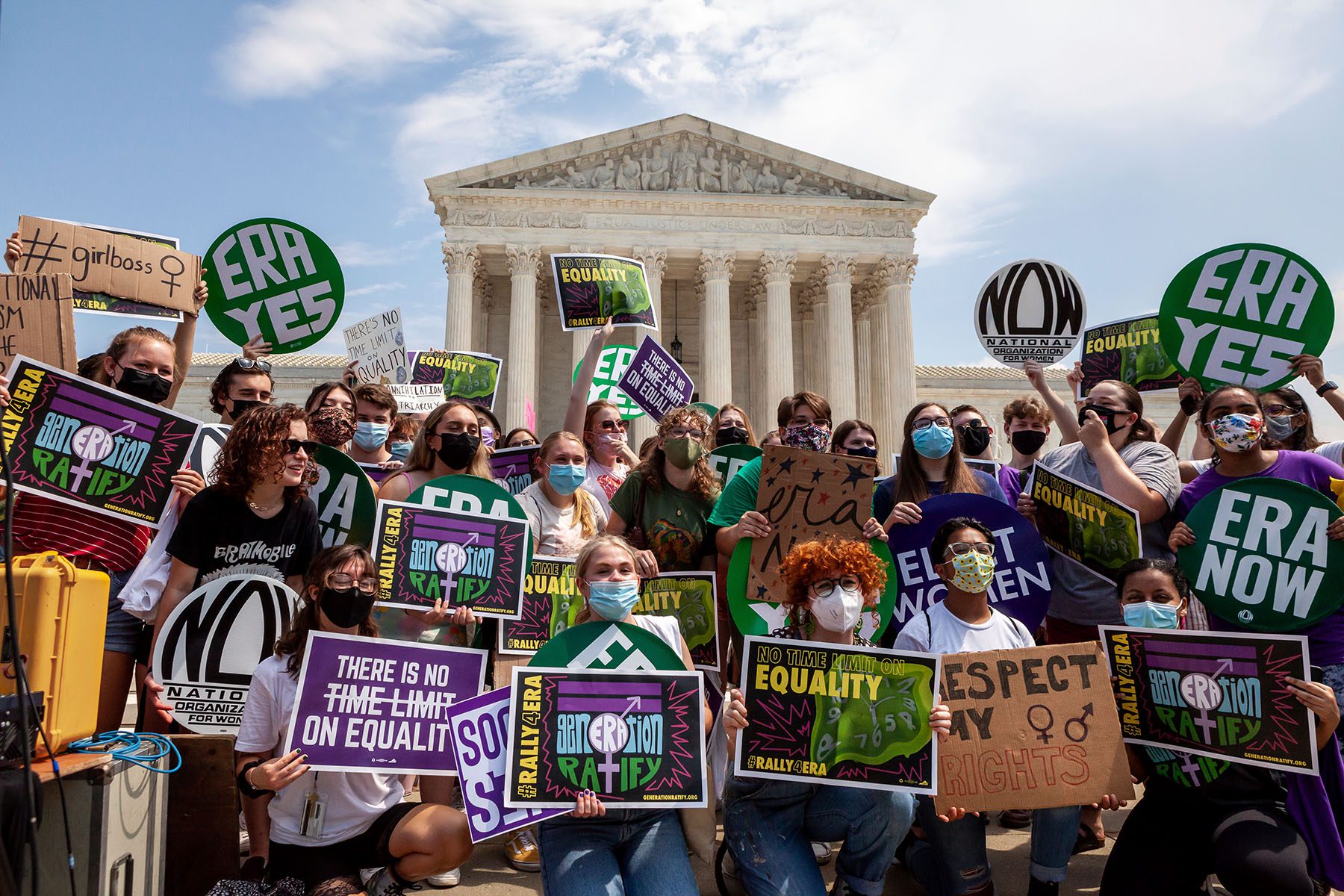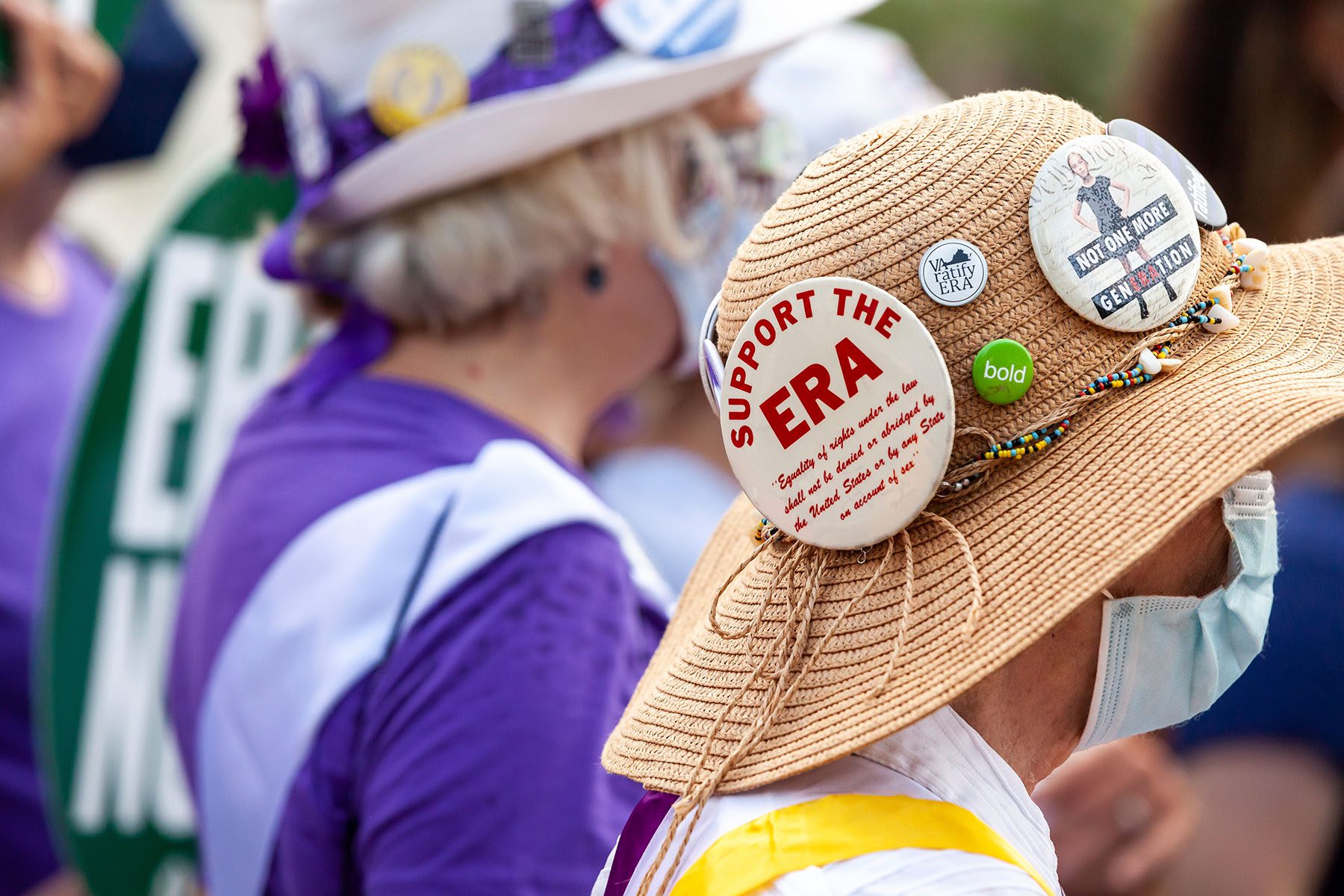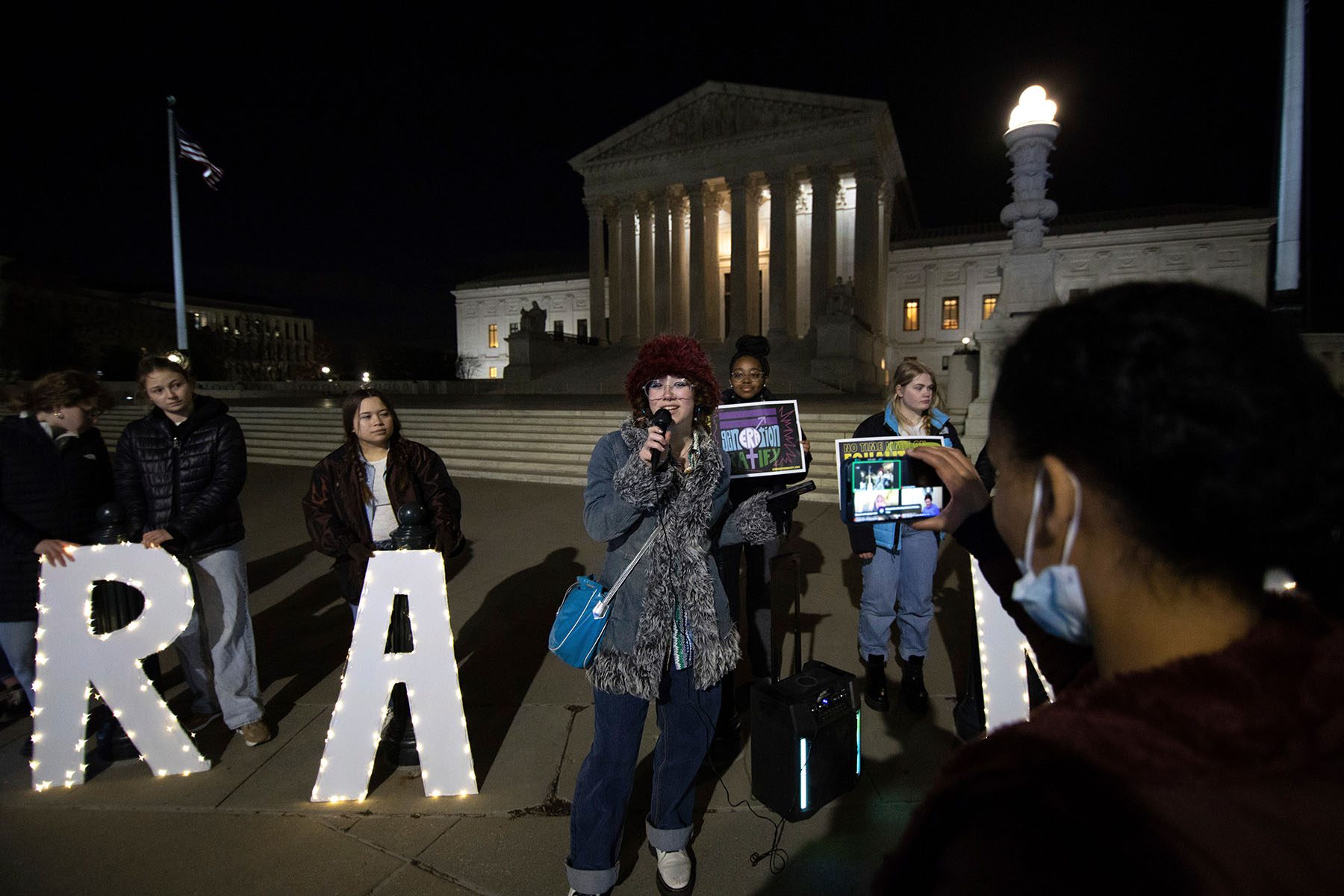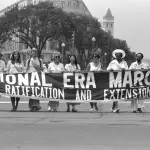The group of young people who gathered outside the White House held large letters that were lit up in the late July night.
They spelled “ERA NOW,” in reference to the Equal Rights Amendment, the gender equality clause that activists have tried to add to the U.S. Constitution for nearly a century. The activists outside the White House, known as Generation Ratify, waved several homemade signs during their three days of lobbying and protesting in Washington, D.C., that explicitly drew a link that many previous ERA activists had been hesitant to: “Defend Abortion = ERA NOW” read one of their other banners. “ABORTION SAVES LIVES!” read another sign.
Lauren Perl, a 19-year-old college sophomore who serves as the federal advocacy director for Generation Ratify, posted a video on the group’s Instagram account about their lobbying efforts to lawmakers: “We are here to tell them that the Equal Rights Amendment is the key to ensuring reproductive autonomy.”
The messaging is a contrast to that of older ERA supporters. While conservatives warned against the ratification of the ERA, saying it could block any restrictions on abortion, supporters of the amendment would say that wasn’t its goal. But now, some are reassessing their approach.
Generation Ratify wants to emphasize their belief, one shared by some legal experts, that the amendment would protect abortion access. It’s a pressing message after the U.S. Supreme Court ruled in June that abortion rights were no longer guaranteed nationwide and at least one justice suggested that other civil rights protections, including marriage equality, should be revisited. The group also argues that the ERA would enforce LGBTQ+ rights and Title IX protections.
But it’s the abortion discussion that has maybe drawn the most attention from older activists.
“For a long time, it was kind of, ‘Don’t talk about that.’ Or, ‘That will just scare off the Republicans, or that will make people in Congress not support the ERA,” said Ting Ting Cheng, director of the ERA Project at the Center for Gender and Sexuality Law at Columbia University. The ERA Project has written legal analysis that ties the ERA to abortion and LGBTQ+ rights. “Whereas for us, it’s sort of, ‘What would you be fighting for if it wasn’t for fundamental bodily autonomy to begin with?’”
Generation Ratify is similar to other youth-led movements that have organized on issues such as climate change, gun violence and student loan debt. The activists, many in high school and college, are organizing at such a young age in part because they expect more from their elected officials after years or sometimes decades of policy inaction, said Kate Kelly, a human rights attorney and activist who supports the ERA and is an adviser to Generation Ratify.
“Gen Z is not having it. Gen Z will not accept anything less than full equality,” she said. “They’re very smart. They’re very connected. They have access to infinite information. When they go online, when they research, they realize, ‘Oh, this all goes back to our fundamental lack of equality at the beginning of this country.’”
The ERA has technically been ratified by enough states over several decades that some scholars believe it is a part of the Constitution. Other experts disagree because of an expired deadline imposed by Congress.
Emma Khodaverdian, the national organizing director for Generation Ratify and another 19-year-old college sophomore, believes if the ERA were officially recognized, it would prevent abortion restrictions, including in statehouses. Khodaverdian said this is particularly relevant now that abortion access will be up to states.
“Really what we want is to be like, ‘This is the solution and our response to the fall of Roe.’ … I feel like we all kind of believe that there should be more of a conversation around what the ERA can do in terms of reproductive rights and access,” she said.
Generation Ratify, which was formed in late 2019, sees a space for policymakers, particularly Democrats, to better communicate to the public the power of the ERA — the proposed text would explicitly state the Constitution does not discriminate on the basis of sex. Some legal experts believe that would protect not just abortion rights but prevent discrimination on the basis of gender identity and sexual orientation in several areas of life, including in the workplace and in cases of sexual assault.
“Democrats lack a united front with regard to abortion,” Perl said. “The Health Protection Act failed. … We strongly believe that the ERA should be that united response because it’s so comprehensive.”

Generation Ratify’s lobbying work in July included meeting with lawmakers in person and virtually, encouraging them to support a resolution that would effectively recognize the amendment. (A lawsuit aimed at recognizing the ERA is also pending; Generation Ratify has filed an amicus brief in the case, one of the first youth groups to take such action.) The group is also advocating for other bills that would protect abortion or address maternal mortality.
The group stationed about two dozen members near Senate Majority Leader Chuck Schumer’s office over two days. They met with the senator’s staff, as well as more than 50 other lawmakers or their staff before camping overnight in front of the White House to urge President Joe Biden to take action on the ERA. Many believe the president could tell the U.S. archivist, a federal government employee, to certify the amendment. Others believe the issue is not up to the archivist. Biden’s public support for the ERA has encouraged Congress to take action.
While conservatives for years have warned that the ERA would blunt efforts to restrict or ban abortion, many Democrats and liberal-leaning groups have denied a connection between the amendment and abortion access.
That has included the ERA Coalition, an organization formed in 2014 that is composed of about 250 national and local groups from across the country. In a now-dated FAQ on the coalition’s site, the group states the amendment isn’t all about protecting abortion.
“The ERA would enhance equality across a variety of areas, including by protecting women from discrimination based on pregnancy, childbirth, and motherhood,” it says. Then it noted that Roe v. Wade protected abortion rights.
But that has recently shifted. Zakiya Thomas, president and CEO of the ERA Coalition and Fund for Women’s Equality, told The 19th that the group evolved its position on abortion as it became clear that the Supreme Court could overturn Roe.
“Linking abortion and the ERA essentially put the two together in a way that put people off to the Equal Rights Amendment, because [opponents] were using it as a wedge issue,” she acknowledged. “We’re confirming that the Equal Rights Amendment impacts a range of rights, including bodily autonomy under the broader scope of enshrining sex equality in the Constitution.”
Generation Ratify is a member of the ERA Coalition. Thomas said it supports the young activists and even tried to send them pizzas when they were on Capitol Hill.
“We uplift the work that they’re doing. We may not always agree with the language that they use, but where our messaging aligns, we’re furthering it,” she said.

Kelly said older ERA activists made a strategic decision to separate the amendment’s impact on abortion.
“These are pro-choice people. It was a strategic question,” said Kelly. “They thought that connecting the two caused them to lose.”
Thomas said she would agree with that assessment.
“There has been a concern in the past that linking the Equal Rights Amendment and abortion would turn more people off,” she said. “But what we’ve seen is now that Roe is gone, that argument is not as strong as it used to be.”
The ERA’s exact impact on abortion rights is unknown, according to some legal experts, who have said it would take a lawsuit to determine the matter. But some court cases in states with their own equal rights amendments could offer a preview. The New Mexico Supreme Court in 1998 struck down a state law that restricted public funding for abortions. In its unanimous ruling, it pointed to the state’s ERA. A Connecticut court in 1986 took similar action.
In Pennsylvania, a lawsuit led in part by Planned Parenthood is arguing that a ban on Medicaid funding to pay for abortions violates the state’s Equal Rights Amendment and other equal protection guarantees. The state Supreme Court is considering the case.
“This is not conjecture,” said Kelly, who also noted a Utah judge this summer temporarily blocked an abortion ban because a lawsuit argued in part that it violated the equal rights amendment in the Utah state constitution. “ … What we’ve been saying is happening. It’s being put to the test. And in a positive way, we’re seeing the constitutional rights to access abortion being utilized and fortified.”
Young pro-ERA activists have not worried about clearly linking the amendment to abortion. Many were born after 2000, when the fight for the ERA still appeared stuck. Lawmakers in statehouses, including women of color and LGBTQ+ people, have been credited with reviving the amendment by getting additional states to ratify the amendment.
“I personally don’t carry that baggage,” said Marisol Pierce Bonifaz, 15. “I believe they are both interconnected.”
Bonifaz founded the first Massachusetts chapter of Generation Ratify when she was 13 and first got involved with Generation Ratify during the pandemic. Bonifaz met virtually with lawmakers along with other members of the group while an in-person cohort was in D.C.
“I have been very aware as a teenager and as a young woman in this world that I am not equal. I’m very aware of that. I’m aware of that when men objectify me on the streets, or catcall me or when I feel unsafe or when I have been told that I must always walk in groups. I cannot walk alone at night. Every young girl growing up has gotten that talk,” Bonifaz said. “And I feel like the Equal Rights Amendment, it would not solve all of our problems. It would provide us a start and we would just be able to say that our government really cares about us, and that our government values our rights and protections under the law.”
Generation Ratify is taking a break during most of August. Many of the activists have to get ready to return to their respective schools.
That didn’t stop the group from sending unicorn-themed thank you cards to lawmakers. And it didn’t stop Perl from sending more than four dozen follow-up emails to lawmakers’ offices a week later.
“Even though we’re technically off, this work never stops,” she said.







